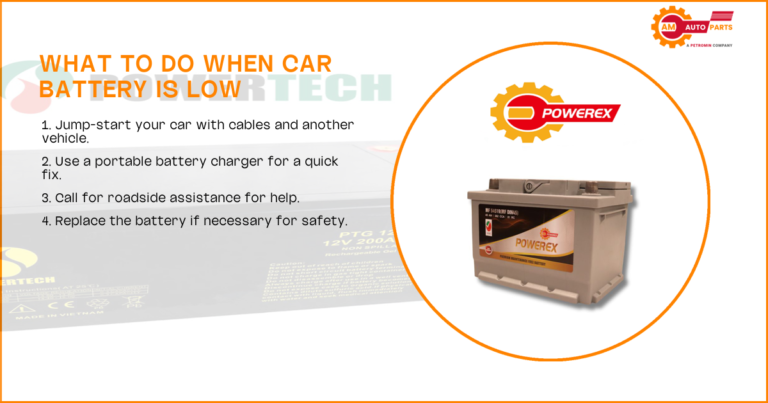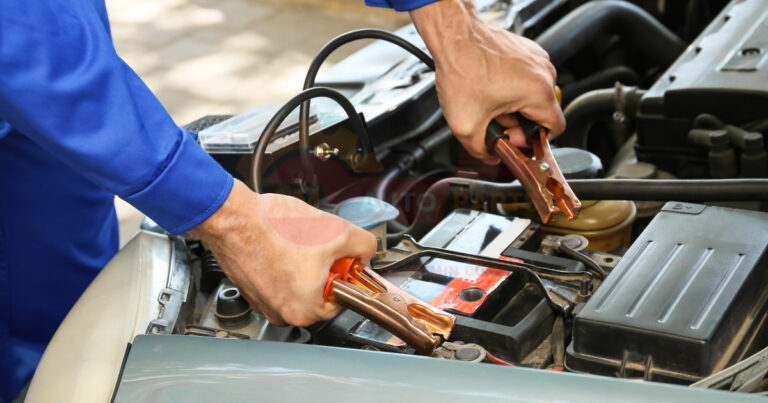What Happens When Car Battery Low: Signs, Causes, and Solutions
What Happens When Car Battery Low
A car battery is the heart of your vehicle’s electrical system. When it runs low, it can lead to a cascade of issues that affect your car’s performance. Understanding what happens when a car battery is low can help you prevent unexpected breakdowns and costly repairs.
Electrical System Failures
When your car battery is low, the electrical system may start to fail. This can manifest in various ways, such as malfunctioning lights, power windows, and other electronic components. A low battery means there’s not enough power to keep these systems running efficiently.
- Malfunctioning lights and electronics
- Power windows and locks may not work
- Radio and dashboard lights may flicker
Engine Starting Issues
One of the most common signs of a low car battery is difficulty starting the engine. The battery provides the initial power needed to start the engine, and a weak battery may struggle to do so.
- Engine may crank slowly or not at all
- Requires multiple attempts to start
- May need a jump start to get going
Reduced Fuel Efficiency
A low battery can also lead to reduced fuel efficiency. This happens because the alternator has to work harder to charge the battery, which in turn uses more fuel.
- Increased fuel consumption
- More frequent trips to the gas station
- Strain on the alternator
Signs of a Weak or Failing Car Battery
Recognizing the signs of a weak or failing car battery can save you from being stranded on the road. Here are some common indicators:
Dim Headlights and Interior Lights
Dim headlights and interior lights are often the first signs of a weak battery. This happens because the battery is unable to provide enough power to keep the lights bright.
- Headlights appear dimmer than usual
- Interior lights flicker or are dim
- Difficulty seeing at night
Slow Engine Crank
A slow engine crank is a telltale sign of a weak battery. If your engine takes longer than usual to start, it might be time to check your battery.
- Engine cranks slowly
- Takes longer to start the car
- May require multiple attempts
Clicking Sound When Turning the Key
If you hear a clicking sound when you turn the key, it could mean your battery is too weak to start the engine. This sound is a result of the starter motor not receiving enough power.
- Clicking noise when starting
- Engine fails to start
- May need a jump start
Swollen Battery Case
A swollen battery case is a physical sign that your battery is failing. This can be caused by excessive heat or overcharging.
- Battery case appears swollen or bloated
- Visible damage to the battery
- May leak battery acid
Frequent Jump Starts Required
If you find yourself needing frequent jump starts, it’s a clear sign that your battery is on its last legs. This indicates that the battery is unable to hold a charge.
- Regularly needing jump starts
- Battery doesn’t hold charge
- Time to consider a replacement
How a Car Battery Works
Understanding how a car battery works can help you diagnose issues and maintain it properly.
Chemical Reactions in Lead-Acid Batteries
Car batteries are typically lead-acid batteries, which rely on chemical reactions to produce electricity. These reactions occur between lead plates and sulfuric acid.
- Lead plates and sulfuric acid create electricity
- Chemical reactions power the car
- Essential for starting the engine
Charging and Discharging Cycles
A car battery goes through charging and discharging cycles. When the engine runs, the alternator charges the battery. When the engine is off, the battery discharges to power the car’s electrical systems.
- Alternator charges the battery
- Battery discharges when engine is off
- Cycles affect battery lifespan
Impact of a Low Battery on Vehicle Performance
A low battery can have several negative impacts on your vehicle’s performance.
Alternator Strain
A low battery puts extra strain on the alternator, which has to work harder to charge the battery. This can lead to premature alternator failure.
- Increased alternator workload
- Potential alternator damage
- Higher repair costs
Decreased Fuel Economy
As mentioned earlier, a low battery can decrease fuel economy. The alternator’s extra workload requires more fuel, leading to increased consumption.
- More fuel used
- Higher fuel costs
- Reduced efficiency
Potential Damage to Electronic Components
A low battery can also damage electronic components in your car. Insufficient power can cause these systems to malfunction or fail.
- Electronic systems may fail
- Potential for costly repairs
- Reduced vehicle reliability
Testing Your Car Battery
Regular testing can help you catch battery issues before they become serious problems.
Multimeter Test
A multimeter test measures the voltage of your battery. A healthy battery should read around 12.6 volts when fully charged.
- Use a multimeter to check voltage
- Healthy battery reads 12.6 volts
- Low voltage indicates a weak battery
Load Test
A load test checks the battery’s ability to hold a charge under load. This test can reveal if the battery is failing.
- Tests battery under load
- Reveals battery’s charge-holding capacity
- Identifies failing batteries
Crank Test
A crank test measures the battery’s performance when starting the engine. It checks if the battery can provide enough power to start the car.
- Measures starting power
- Checks battery’s performance
- Identifies starting issues
Can a Low Battery Affect Gas Mileage?
Yes, a low battery can affect gas mileage. When the battery is low, the alternator has to work harder to charge it, which uses more fuel. This increased fuel consumption can lead to decreased gas mileage, making your car less efficient.
Causes of Car Battery Drain
Several factors can cause your car battery to drain, leading to a low charge.
Parasitic Draws
Parasitic draws occur when electrical components continue to draw power even when the car is off. This can drain the battery over time.
- Electrical components draw power
- Battery drains when car is off
- Can lead to a dead battery
Extreme Temperatures
Extreme temperatures, both hot and cold, can affect battery performance. High heat can cause the battery to overcharge, while cold temperatures can reduce its ability to hold a charge.
- High heat causes overcharging
- Cold reduces charge capacity
- Affects battery lifespan
Short Trips and Infrequent Use
Short trips and infrequent use can prevent the battery from fully charging. This can lead to a gradual loss of charge over time.
- Short trips prevent full charging
- Infrequent use drains battery
- Leads to a weak battery
How Long Does a Car Battery Last?
A car battery typically lasts between 3 to 5 years under normal conditions. However, factors like extreme temperatures, frequent short trips, and lack of maintenance can shorten its lifespan. Regular testing and maintenance can help extend the life of your battery.
Maintaining Your Car Battery
Proper maintenance can extend the life of your car battery and prevent unexpected failures.
Regular Cleaning and Inspection
Regular cleaning and inspection can prevent corrosion and ensure the battery is in good condition. Check for any signs of damage or wear.
- Clean battery terminals regularly
- Inspect for damage or wear
- Prevents corrosion
Proper Charging Habits
Proper charging habits can help maintain your battery’s health. Avoid overcharging and ensure the battery is fully charged after use.
- Avoid overcharging
- Ensure full charge after use
- Extends battery life
Addressing Corrosion Issues
Corrosion can affect battery performance. Regularly clean the terminals and apply a protective coating to prevent corrosion.
- Clean terminals regularly
- Apply protective coating
- Prevents performance issues
When to Replace Your Car Battery
Knowing when to replace your car battery can prevent unexpected breakdowns.
Age-Related Deterioration
Car batteries naturally deteriorate over time. If your battery is over three years old, it may be time to consider a replacement.
- Batteries deteriorate with age
- Consider replacement after three years
- Prevents unexpected failures
Persistent Starting Problems
If you experience persistent starting problems, it may be a sign that your battery needs replacing. Frequent jump starts are a clear indicator.
- Persistent starting issues
- Frequent jump starts needed
- Time for a new battery
Failed Battery Tests
If your battery fails a multimeter, load, or crank test, it’s time to replace it. These tests can reveal underlying issues that affect performance.
- Failed battery tests
- Indicates underlying issues
- Replacement needed
What Happens When Car Battery Low While Driving?
When a car battery is low while driving, the alternator takes over to power the vehicle’s electrical systems. However, if the alternator fails or the battery is too weak, the car may stall. This can lead to a loss of power steering and brakes, making it dangerous to drive. Battery Dimensions Automotive refers to the size and shape of batteries used in cars and trucks These measurements are important to make sure the battery fits properly in different vehicle models Battery lifespan vehicles Electric cars can drive for many years before their batteries need to be replaced which helps save money and is good for the environment
Jumpstart dead battery is a quick way to get your car running again when the battery is out of power You can use special cables to connect your car’s dead battery to another car’s working battery to bring it back to life Battery voltage range The
Battery selection guide Choose the right battery for your device by looking at size voltage and how long it lasts Extend car battery life by turning off lights and electronics when not in use Regular maintenance and proper charging can help
Electric vehicle safety is about making sure electric cars are safe to drive and use These cars have special features to protect people from electrical problems and accidents Battery charging troubles can be frustrating when your device won’t power up Try different chargers or outlets to fix
Automotive energy solutions help cars and trucks use different types of power to run These solutions include electric batteries hydrogen fuel cells and cleaner fuels for vehicles
Choosing the Right Replacement Battery
Choosing the right replacement battery is crucial for your vehicle’s performance.
Compatibility with Your Vehicle
Ensure the replacement battery is compatible with your vehicle’s make and model. Check the owner’s manual for specifications.
- Check compatibility with vehicle
- Refer to owner’s manual
- Ensures proper fit and function
Cold Cranking Amps (CCA) Rating
The CCA rating indicates the battery’s ability to start the engine in cold weather. Choose a battery with a suitable CCA rating for your climate.
- CCA rating for cold starts
- Suitable for your climate
- Ensures reliable starting
Reserve Capacity
Reserve capacity measures how long the battery can power the car’s electrical systems if the alternator fails. Choose a battery with a good reserve capacity for added reliability.
- Measures backup power
- Ensures reliability
- Important for emergencies
By understanding what happens when a car battery is low and taking proactive steps to maintain it, you can ensure your vehicle runs smoothly and efficiently. Regular testing, proper maintenance, and timely replacement can prevent unexpected breakdowns and keep your car in top condition.
FAQ’s
What are the signs of a low car battery?
Common signs include dim headlights, slow engine cranking, dashboard warning lights, or difficulty starting the vehicle.
Can I still drive with a low car battery?
Driving might be possible, but it increases the risk of the car stalling or failing to start, especially if the alternator cannot recharge the battery effectively.
How can I fix a low car battery?
Solutions include recharging the battery using a charger, jump-starting the car, or replacing the battery if it is old or damaged.






